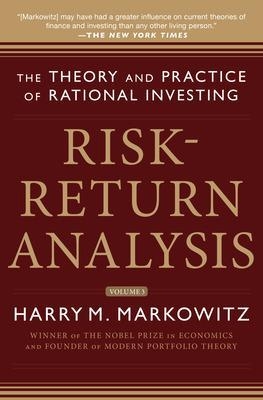
Risk-Return Analysis Volume 3
McGraw-Hill Inc.,US (Verlag)
978-0-07-181831-5 (ISBN)
When Harry Markowitz introduced the concept of examining and purchasing a range of diverse stocks—in essence, the practice of creating a portfolio—he transformed the world of investing. The idea was novel, even radical, when he presented it in 1952 for his dissertation. Today, it’s second-nature to the majority of investors worldwide.
Now, the legendary economist returns with the third volume of his groundbreaking four-volume Risk-Return Analysis series, where he corrects common misperceptions about Modern Portfolio Theory (MPT) and provides critical insight into the practice of MPT over the last 60 years. He guides you through process of making rational decisions in the face of uncertainty—making this a critical guide to investing in today’s economy.
From the Laffer Curve to RDM Reasoning to Finite Ordinal Arithmetic to the ideas and concepts of some of history’s most influential thinkers, Markowitz provides a wealth and depth of financial knowledge, wisdom, and insights you would be hard pressed to find elsewhere.
This deep dive into the theories and practices of the investing legend is what you need to master strategic portfolio management designed to generate profits in good times and bad.
Harry M. Markowitz is president of Harry Markowitz Co. in San Diego. In 1990, he was jointly awarded the Nobel Prize for economics with Merton Miller and William Sharpe.
Preface
The Rational Decision Maker
Words of Wisdom
John von Neumann
Acknowledgments
13. Predecessors
Introduction
René Descartes
There Is No “Is,” Only “Was” and “Will Be”
Working Hypotheses
RDM Reasoning
David Hume
Eudaimonia
Financial Economic Discoveries
Economic Analyses That Have Stood
the Test of Time
Constructive Skepticism
Isaac Newton, Philosopher
Fields Other Than Physics
Karl Popper
Mysticism
Caveats
Charles Peirce
Immanuel Kant
What an RDM Can Know A Priori
14. Deduction First Principles
Introduction
The Great Debate
One More Reason for Studying
Cantor’s Set Theory
“Very Few Understood It”
Finite Cardinal Arithmetic
Relative Sizes of Finite Sets
Finite Ordinal Arithmetic
Standard Ordered Sets (SOSs)
Finite Cardinal and Ordinal Numbers
Cantor (101)
Theorem
Proof
Corollary
Proof
Transfinite Cardinal Numbers
The Continuum Hypothesis
Transfinite Cardinal Arithmetic
Lemma
Transfinite Ordinal Numbers
Examples of Well-Ordered and
Not Well-Ordered Sets
Transfinite Ordinal Arithmetic
Extended SOSs
Lemma
Proof
The Paradoxes (a.k.a. Antimonies)
Three Directions
From Aristotle to Hume to Hilbert
British Empiricism versus Continental
Rationalism
Who Created What?
Cantor Reconsidered
Brouwer’s Objections
Axiomatic Set Theory
Peano’s Axioms (PAs)
Hilbert’s Programs
Whitehead and Russell
Zermelo’s Axioms
The “Axiom of Choice”
The Trichotomy Equivalent to the Axiom of Choice
Kurt Gödel (1906–1978)
Thoralf Skolem (1887–1863)
15. Logic is Programming is Logic
Introduction
Terminology
Number Systems and the EAS Structures
Built on Them
Deductive Systems as Programming Languages
A Variety of Deductive DSSs
Alternative Rules of Inference
“Ladders” and “Fire Escapes”
Organon 2000: From Ancient Greek
to “Symbolic Logic”
So, What’s New?
Immediate Consequences
Two Types of Set Ownership
Modeling Modeling
EAS-E Deduction: Status
16. The Infinite and The Infinitesimal
Points and Lines
Fields
Constructing the Infinitesimals
Infinite-Dimensional Utility Analysis
The Algebraic Structure Called “A Field”
17. Induction Theory
Introduction
The Story Thus Far
Concepts
Basic Relationships
Examples
“Objective” Probability
The Formal M59 Model
Initial Consequences
Bayes’s Rule
A Bayesian View of MVA
Judgment, Approximation and Axiom III
(1) A Philosophical Difference between
S54 and M59
Examples of Clearly “Objective” Probabilities”
Propositions about Propositions
A Problem with Axiom II
Are the πj
Probabilities the Scaling of the πj
?
The πj
“Mix on a Par” with Objective Probabilities
18. Induction Practice
Introduction
R. A. Fisher and Neyman-Pearson Hypothesis Tests
The Likelihood Principle
Andrei Kolmogorov
A Model of Models
The R.A. Fisher Argument
Bayesian Conjugate Prior Procedures
19. Eudaimonia
Review
Eudaimonia for the Masses
Notes
References
Index
| Erscheinungsdatum | 24.04.2020 |
|---|---|
| Zusatzinfo | 40 Illustrations |
| Verlagsort | New York |
| Sprache | englisch |
| Maße | 160 x 236 mm |
| Gewicht | 558 g |
| Themenwelt | Wirtschaft ► Betriebswirtschaft / Management ► Allgemeines / Lexika |
| ISBN-10 | 0-07-181831-6 / 0071818316 |
| ISBN-13 | 978-0-07-181831-5 / 9780071818315 |
| Zustand | Neuware |
| Haben Sie eine Frage zum Produkt? |
aus dem Bereich


